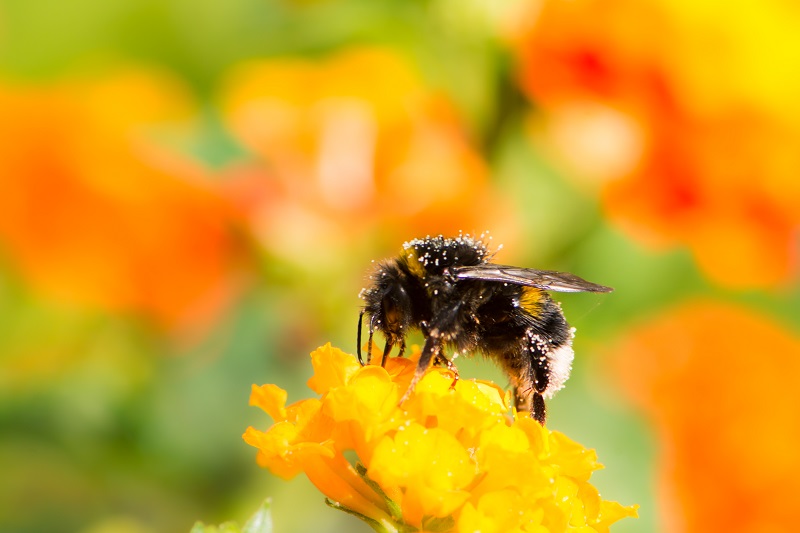
The loss of our vital pollinators is due to temperature extremes and fluctuations and it could have severe consequences for our ecosystems and agriculture.
Bumblebees are among the most important pollinators and they are in trouble. Buzzy and buzzy, they spread the pollen and fertilize many types of wild flora, as well as other important agriculture crops like tomatoes, squash, and blueberries.
However, their number continues to drop. New research using a massive dataset found that bumblebees are far less common than they used to be. In North America, there are 50% fewer chances to see a bumblebee than there were in 1974.
Additionally, many common species have disappeared from many areas they once existed in, becoming locally extinct in those places. The rusty patched bumblebee, which used to flourish in Ontario can no longer be found in all of Canada, and in the U.S. it is endangered.
A recent study published in the Science journal, researchers used a modeling process to suggest that their extinction is caused mainly by climate change. Moreover, the scientists discovered that in the areas that have become hotter in the last years of which have experienced many extreme temperature swings, the bumblebee’s number is reduced.
In Europe, there are 17% fewer insects than they were in the early 20th century. In addition, researchers analyzed the abundance of 66 species found across the two continents.
They suggest that climate chaos is the main cause that stands behind their drop, according to study leader Peter Soroye, a doctoral student at the University of Ottawa.
“These declines are linked to species being pushed beyond temperatures they haven’t previously had to tolerate,” Soroye says. Their disappearance from a certain region can only mean that they’ve moved elsewhere or died.
Cool specialists
It is well known that bumblebees are more suited to cold weather, due to their fuzzy bodies and their ability to generate heat while flying, allowing them to be the first bees that appear early in the spring. However, how sensitive they are to hot weather and fluctuations is still unclear for most species, even though this study suggests there’s a limit to their ability.
And for a good reason, because the last five years were the hottest ever recorded in the 149 years tracked by the U.S. National Oceanic and Atmospheric Administration.
There are more mechanisms at play, says study co-author Jeremy Kerr. The insects can just overheat, as many lab experiments have shown previously, but there may also be changes on vegetation and flowers that can cause bees to starve, he adds. Bumblebees have a short life, they live a year at most, and their queens spend the winter in leaf litter or in the ground. Here, they are still vulnerable to shifts in temperature, and things like unusually early ice melt and re-freezes, Kerr says.
Their disappearance is very dangerous for the environment since their services are important for the reproduction of many flowering plants, says Matthew Austin, a Ph.D. student, and researcher at the University of Missouri in St. Louis who wasn’t involved in the paper.
“As these plants are then used by myriad other organisms, the decline of bumblebees can have cascading ecological [effects] that may collectively cause biodiversity loss.”
Moreover, their extinction could also generate other economic costs. By one measure, bees contribute more than $15 billion to the U.S. economy by pollinating crops.
Other reasons for their decline
However, climate change may not be the only factor that stands behind the bumblebee’s decline. A threat is given by pesticides like neonicotinoids, which can be extremely toxic for bees, destructing their habitat by changing the wildlands into agriculture and the release of non-native bees for commercial pollination.
“This study will be impactful in drawing scientists’ attention more to the role climate may play in the declines of these bees,” said Heather Hines, a researcher at Penn State University who wasn’t involved in the research. “That said, their data shows that while climate can explain declines to a large degree, it is not the only factor involved in explaining the overall decline in species richness observed over time.”
“What we’re pointing out is that there’s a strong climate change signal,” he adds. “If you ignore the climate change signal, you can’t understand extinction risk clearly.” (Read more: Why insect populations are plummeting—and why it matters.)
“While bees might be able to cope with one stressor alone, the combination of several stressors may bring a population over the tipping point,” says Matthias Becher, an ecologist with Exeter University in the U.K.
Some researchers went further. Jamie Strange, chair of the entomology department at Ohio State University, explained that focusing on climate change could lead to many problems because it ignores the many other causes of decline.
“My concern is not that their science is wrong, but that this work will draw the focus from some of the issues that desperately need to be addressed to save bee populations,” Strange says, which “are all equally or more pressing than climate change to impacting bee populations worldwide.”
How to help
There is good news, however, Soroye adds. Even though the extreme temperatures affect the bumblebees, creating more green spaces, like parks, or planting more trees and shrubs in urban environments, could give them places to “hide” from the heat.
Another solution to take into consideration if you want to help save their lives is planting native flowers for the bumblebees to feed on, but it is important to avoid using pesticides like neonicotinoids. Also, creating flower beds that are continuously in bloom is helping a lot.
Additionally, wait until spring to remove leaf litter, because it is a prime denning spot for the insects.











































